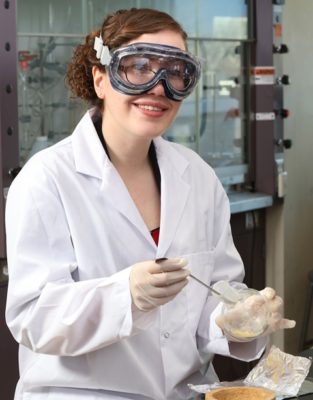Guanine Quadruplex Stabilization
By Caitlin E. Miron
DNA: the library of genetic information that dictates the development and function of our bodies. This information is stored as a code of four elements: the nucleobases cytosine, guanine, adenine, and thymine. Although DNA is most frequently portrayed as a double-stranded helix, this code can only be read when regions of the double helix become temporarily single-stranded.
Picture a necklace, where the chain is that single strand of DNA, and the beads are the cellular machinery needed to translate sections of DNA into proteins that will participate in necessary cellular events. These beads move along the chain until they reach a knot. The “knots”, which are known as guanine quadruplexes, form in guanine-rich regions of single-stranded DNA – or RNA – through contacts similar to those that drive the formation of a double-stranded helix. Normally, specific proteins called helicases are tasked with unravelling these knots, but if there was a way to stabilize that knot, to glue it into place, then it would act as a physical barrier, blocking the beads’ access to the region of DNA beyond it. If this region codes for a protein, stabilizing the knot would prevent the production of this protein and thereby silence its activity.
The possibility that quadruplexes could be targeted for therapeutic applications was first raised in the 1980s, when researchers discovered that these knots could form in DNA telomeres. During cell division, DNA is packaged up into X-shaped structures called chromosomes and split between cells. Although some DNA at the chromosomal end can be lost each time this process occurs, critical information is not at risk because this region of DNA, called a telomere, does not code for anything. Once telomeres have shortened to a dangerous extent, the cell will no longer divide. In 85% of cancer cells, an enzyme called telomerase lengthens telomeres, leading to “immortal” cancer cells that can divide continuously. Telomerase is not, however, active in most healthy cells. The presence of quadruplexes in human telomeres thus offered an exciting opportunity to selectively target cancer cells. If these knots could be stabilized, telomerase would be unable to access the telomere and the process that leads to cancer cell immortalization could be shut down.

The search for chemical compounds that could stabilize quadruplexes was consequently well underway by the 2000s, when bioinformatics highlighted the prevalence of quadruplex-forming sequences at the start of oncogenes – sections of DNA which code for proteins that contribute to aspects of cancer development ranging from the formation of new blood vessels to cancer metastasis. The scope of guanine quadruplex research broadened as quadruplex stabilizers – acting as glues for the knots – were shown to prevent the processing of such oncogenes, leading to effects such as reduced cancer cell growth.
This was the extent of my knowledge of the field of guanine quadruplex recognition when funding from NSERC, Mitacs Globalink, and Queen’s University allowed me to conduct two research internships at the European Institute of Chemistry and Biology in Bordeaux, France, thereby continuing a collaboration between my supervisor, Dr. Anne Petitjean, and Dr. Jean-Louis Mergny, one of the top experts in the field. The focus was on fundamental research: were any of the compounds synthesized in our lab for projects related to DNA recognition effective quadruplex binders? My research, considerably accelerated by the expertise of the Mergny group, led to the identification of a hit compound. We’d found a glue – a guanine quadruplex stabilizer – that was performing as well or better than any of the known standards in the field. Better yet, this was a glue that also showed little to no binding to the DNA double helix; an essential feature when attempting to selectively target an architecture present in much lower abundance than duplex DNA in cells. Through the NIH National Cancer Institute’s screening platform, we were recently able to show that this initial hit compound, along with several second-generation derivatives, did reduce cell growth in five human cancer cell lines.
Although these results are highly promising, questions remain to be answered at a fundamental level. What makes these compounds so effective? Do they, like other binders before them, prevent oncogenes from being accessed by cellular machinery? What features can be modified to improve biocompatibility? Will they be more potent in combination with other therapies? These are factors that must be considered as we move towards drug development and before we start a serious conversation about clinical trials.
Ultimately, it is our hope that our novel family of quadruplex “glues” can be used as effective and perhaps broad-spectrum anticancer agents. Guanine quadruplex recognition shows exceptional promise for cancer therapeutics, and as research in the field progresses, we are learning that these knots may be involved in the development of other diseases as well. Quadruplexes, for instance, also play critical roles in regulating processes such as infection by HIV. Can we use quadruplex stabilizers to stop cancer in its tracks? Prevent infection by HIV? Guanine quadruplex recognition, as a field, is not yet there. The identification of these new quadruplex stabilizers, however, may represent an important step forward towards that goal.
Caitlin E. Miron is a fourth-year PhD candidate from the Petitjean group in the Department of Chemistry at Queen’s University. She was recently awarded the Mitacs 2017 Award for Outstanding Innovation (PhD




